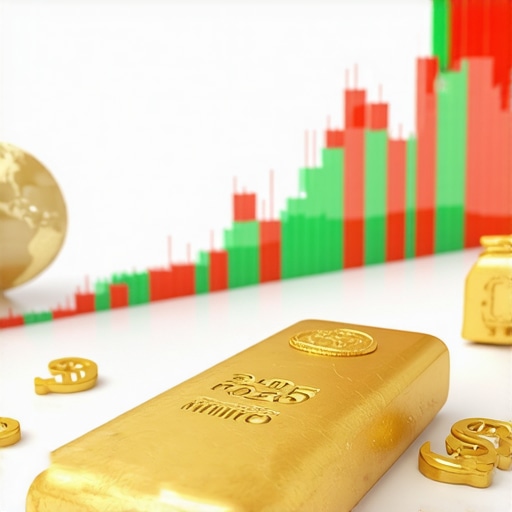Introduction to Gold Demand Dynamics
Gold has always held a unique place in the world of investments and economies. As an asset class, its value is influenced by a wide range of factors. Understanding gold demand is crucial for both seasoned investors and newcomers alike, especially as global dynamics shift. In this article, we will explore the key factors affecting gold demand and provide insights into how these can impact investment strategies.
Economic Indicators Influencing Gold Demand
The demand for gold is significantly influenced by various economic indicators. One of the primary factors to watch is inflation. When inflation rises, the purchasing power of currency declines, which often leads investors to seek gold as a safe haven. This behavior is particularly evident during periods of high inflation, where gold is viewed as a hedge against currency devaluation. If you want to learn more about this, check out our article on Understanding Gold as a Hedge Against Economic Downturns.
Another crucial economic indicator is interest rates. Gold does not yield interest, which means when interest rates rise, the opportunity cost of holding gold increases. Investors may turn to interest-bearing assets instead, reducing demand for gold. Therefore, monitoring central bank policies and interest rate trends can provide valuable insights into future gold demand.
The Role of Geopolitical Stability
Geopolitical events and market stability also play a vital role in gold demand. In times of uncertainty—whether due to political unrest, economic crises, or global conflicts—investors typically flock to gold as a safe haven. This phenomenon can lead to significant spikes in demand. For example, during global crises, such as the COVID-19 pandemic, gold prices surged as investors sought stability. To delve deeper into how gold can serve as a hedge against uncertainty, read our piece on The Role of Gold in Economic Uncertainty: Why Choose Gold as a Hedge?.
Technological Advancements and Gold Demand
Interestingly, technological advancements also shape gold demand. The rise of gold in technology—particularly in electronics and renewable energy—creates additional demand. As industries evolve, the need for gold in manufacturing processes increases, contributing to overall demand. Investors should consider the impact of technological trends when assessing their gold investment strategies. For more insights on diversifying your portfolio, explore our article on Gold Stocks and Mutual Funds: Diversifying Your Portfolio.
Market Sentiment and Gold Prices
Market sentiment is another significant factor influencing gold demand. Investor psychology can drive prices up or down, often independent of fundamental factors. For instance, if there’s a collective belief that a market downturn is imminent, gold demand may spike as investors rush to secure their assets. Understanding market sentiment can be pivotal for investors looking to time their entry or exit in the gold market.
In conclusion, understanding the various factors influencing gold demand is essential for making informed investment decisions. By keeping an eye on economic indicators, geopolitical events, technological advancements, and market sentiment, investors can better navigate the complex landscape of gold investments. For an in-depth guide on buying gold, check out our comprehensive article on Gold Investment: A Comprehensive Guide to Buying Gold.
Understanding Gold Supply and Demand Trends
In addition to the factors that boost gold demand, it’s equally important to analyze the supply side of the equation. The balance between gold supply and demand significantly affects gold prices. For instance, if gold mining output decreases due to geopolitical tensions or natural disasters, this can lead to higher prices as investors scramble to secure their assets. To gain a better understanding of these trends, check out our detailed analysis on Understanding Gold Supply and Demand in 2025.
The Impact of Central Banks on Gold Demand
Central banks around the world play a pivotal role in the gold market. Their policies regarding gold reserves can influence global gold prices. When central banks buy gold, it typically signals confidence in the asset, prompting other investors to follow suit. Conversely, when they sell gold, it can lead to decreased demand and lower prices. Monitoring central bank actions is crucial for investors wanting to stay ahead of market trends. For insights into how central banks affect gold markets, refer to How Central Banks Affect Gold Market Trends Today.
Gold as a Hedge Against Economic Uncertainty
Investing in gold is often seen as a strategic move during economic downturns. Many investors turn to gold during times of uncertainty, viewing it as a stable asset that retains value. This trend is particularly pronounced during stock market volatility or economic crises. Understanding gold’s role as a hedge can help investors make informed decisions. Explore more about this protective aspect of gold in our article Understanding Gold as a Hedge Against Economic Downturns.
Global Economic Events and Their Effect on Gold Prices
Global economic events significantly impact gold prices. Factors such as trade wars, inflation rates, and shifts in currency strength can lead to fluctuations in gold demand. For example, during a currency crisis, gold is often seen as a safe haven, driving up demand. Investors should remain vigilant about global economic news to anticipate potential impacts on gold prices. For more on this topic, visit How Economic Changes Affect Gold Prices Today.
Investing Strategies for Gold
As the demand for gold evolves, so do the strategies for investing in it. Investors can choose from various options, including physical gold, gold ETFs, and gold mining stocks. Each investment type has its advantages and risks. For beginners, understanding the differences between these options is crucial for making informed decisions. Our guide on How to Invest in Gold for Beginners: A Simple Guide offers valuable insights for those looking to start their gold journey.
Maximizing Returns with Gold Investments
Maximizing returns in gold investments requires a strategic approach. Investors should consider diversifying their portfolios by including various gold-related assets, such as gold stocks, ETFs, and physical gold. This diversification can help mitigate risks and enhance potential returns. For in-depth strategies, check out Investing in Gold: 10 Strategies for Maximum Returns.
In conclusion, understanding the dynamics of gold demand is essential for navigating the investment landscape. By keeping abreast of economic indicators, central bank policies, and global events, investors can position themselves for success in the gold market. Remember that thorough research and strategic planning are key components of any successful investment in gold.
Diverse Gold Investment Options
Investors looking to capitalize on the gold market in 2025 have a variety of options available, each with its own set of pros and cons. The primary types of gold investments include physical gold, gold coins, gold ETFs, and gold mining stocks. Understanding these options allows investors to tailor their strategies based on their financial goals and risk tolerance. For those interested in exploring the differences between gold bullion and coins, our resource on Gold Bullion vs. Gold Coins: Which is the Better Investment? provides a comprehensive overview.
Physical Gold: An Original Investment
Investing in physical gold, such as bars and coins, offers a tangible asset that can provide security during economic uncertainty. However, purchasing physical gold involves considerations such as storage, insurance, and liquidity. Many investors choose to allocate a portion of their portfolio to physical gold as it provides a hedge against inflation and currency devaluation. If you want to learn how to effectively invest in physical gold, check out our guide on Investing in Physical Gold: Common Misunderstandings.
Gold ETFs: A Flexible Investment Approach
Gold Exchange-Traded Funds (ETFs) have become increasingly popular due to their convenience and liquidity. These funds allow investors to gain exposure to gold prices without the need to hold physical assets. Gold ETFs can be a great way to diversify your portfolio and reduce risk. For insights into the best gold ETFs to consider in 2025, refer to our article on Top Gold ETFs You Should Know About for 2025.
Investing in Gold Stocks: Opportunities and Risks
Gold mining stocks can provide leveraged exposure to gold prices, making them an attractive option for some investors. However, investing in gold stocks comes with its own set of risks, including operational challenges and fluctuating stock prices. Understanding the factors driving gold mining stocks is crucial for making informed investment decisions. For a thorough analysis of gold mining stocks and what to look for in 2025, check our post on Key Insights into Gold Mining Stocks for 2025 Investors.
Strategic Diversification in Gold Investments
To maximize potential returns and minimize risks, strategic diversification is key. By spreading investments across different types of gold assets—such as physical gold, ETFs, and mining stocks—investors can create a well-rounded portfolio that can withstand market fluctuations. Additionally, incorporating gold into a broader investment strategy can enhance overall portfolio performance. For tips on building a diverse gold investment portfolio, visit our guide on How to Build a Diverse Gold Investment Portfolio.
Staying Informed on Gold Market Trends
Market trends can significantly impact gold investment strategies. Investors should stay updated on factors influencing gold prices, such as global economic conditions, interest rates, and geopolitical events. By being informed, you can make timely decisions that align with market movements. For insights on current trends affecting gold prices, refer to our article on Current Trends in Gold Price: What to Watch For.
In summary, understanding the various strategies available for investing in gold can position investors for success in 2025. Whether opting for physical gold, ETFs, or mining stocks, careful consideration of risks and opportunities will be essential in navigating the evolving gold market.
Gold as a Safe Haven Investment
Investors often turn to gold during periods of economic instability, viewing it as a safe haven asset. Historically, gold has maintained its value and purchasing power even when other investments falter. This characteristic makes it a crucial component of a diversified investment portfolio, especially in uncertain economic climates. For those interested in understanding how gold serves as a hedge against economic downturns, our article on Understanding Gold as a Hedge Against Economic Downturns offers in-depth insights.
The Role of Gold During Inflationary Pressures
Inflation can erode the purchasing power of fiat currencies, leading investors to seek refuge in gold. Historically, during inflationary periods, gold prices tend to rise as demand increases. This trend highlights the importance of including gold in your investment strategy, particularly during times when inflation appears to be on the rise. For more information on how to navigate inflation through gold investment, check out our guide on How Gold Prices Correlate with Global Economic Events.
Analyzing Global Economic Events and Gold Prices
Global events such as geopolitical tensions, financial crises, and major policy changes can significantly influence gold prices. Investors must stay informed about these developments to make timely decisions regarding their gold investments. Understanding the correlation between these events and gold prices can enhance your investment strategy. Our post on How Economic Changes Affect Gold Prices Today provides valuable insights into these dynamics.
The Impact of Central Banks on Gold Demand
Central banks play a significant role in the gold market, as they often hold substantial gold reserves as part of their monetary policy. Changes in central bank policies, such as interest rate adjustments or gold purchasing strategies, can impact gold demand and prices. For a deeper understanding of how central banks influence the gold market, read our article on How Central Banks Affect Gold Market Trends Today.
Gold Investment Strategies for Economic Resilience
To build resilience against economic downturns, investors should adopt various strategies when investing in gold. This may include diversifying into different forms of gold investments, such as physical gold, ETFs, and mining stocks. Each type of investment offers unique benefits and risks that can help create a balanced portfolio. For a comprehensive overview of gold investment strategies, refer to our guide on Investing in Gold: 10 Strategies for Maximum Returns.
Maximizing Returns Through Smart Gold Trading Techniques
Effective trading techniques can help investors maximize returns from their gold investments. Keeping abreast of market trends, employing technical analysis, and understanding trading indicators can enhance investment decisions. For more tips on trading gold effectively, check out our resource on Exploring Effective Strategies for Gold Trading.
Final Thoughts on Gold Investment Strategies
In conclusion, understanding the diverse strategies available for investing in gold is essential for navigating the complexities of the financial market. By leveraging gold as a hedge against economic downturns, investors can protect their wealth while potentially benefiting from price appreciation. Whether you choose to invest in physical gold, gold ETFs, or mining stocks, the key is to remain informed and strategic in your approach. With the right knowledge and resources, you can position yourself for success in the evolving gold market.
Frequently Asked Questions About Investing in Gold
What are the advantages of investing in gold?
Investing in gold offers several advantages, including its ability to act as a hedge against inflation, its intrinsic value, and its historical reliability during economic downturns. Additionally, gold is a tangible asset that can diversify your investment portfolio, providing stability in uncertain times.
How does gold perform during economic downturns?
During economic downturns, gold typically maintains or increases in value as investors seek safe haven assets. Its performance is often inversely correlated with stock market trends, meaning when stocks decline, gold prices usually rise, making it a protective investment against financial instability.
What types of gold investments are available?
There are several types of gold investments, including physical gold (bars and coins), gold exchange-traded funds (ETFs), and gold mining stocks. Each type offers unique benefits and risks, allowing investors to choose the method that best suits their financial goals and risk tolerance.
How can I determine the right time to invest in gold?
The right time to invest in gold can depend on various factors, including economic indicators, inflation rates, and global events. Keeping abreast of market trends and expert analyses can help you make informed decisions about the optimal timing for your gold investments.
Is investing in gold safe?
While investing in gold is generally considered safe, like all investments, it carries risks. Gold prices can be volatile, and factors such as changes in interest rates, currency value fluctuations, and geopolitical tensions can impact its performance. It’s essential to conduct thorough research and consider diversifying your investments to mitigate risks.
How should I store my physical gold investments?
Physical gold should be stored securely to protect it from theft or damage. Options include safe deposit boxes at banks, private vaults, or home safes. Ensuring that your gold is adequately insured can also provide peace of mind and financial protection.
What are gold ETFs, and how do they work?
Gold ETFs are exchange-traded funds that track the price of gold and allow investors to buy shares that represent a portion of a physical gold holding. They provide a convenient way to invest in gold without the need to store physical assets and can be traded like stocks on major exchanges.
Can gold mining stocks be a good investment?
Gold mining stocks can provide exposure to gold prices while potentially offering higher returns due to operational efficiencies and profit margins. However, they also carry risks associated with mining operations, including regulatory issues and operational costs, which can affect stock performance.
How do global events affect gold prices?
Global events, such as geopolitical tensions, economic crises, and changes in monetary policy, can significantly impact gold prices. Investors often turn to gold during times of uncertainty, driving up demand and prices. Staying informed about global economic developments can help you anticipate changes in the gold market.
Conclusion
In summary, investing in gold presents a robust strategy for safeguarding wealth and enhancing portfolio diversification, especially during economic uncertainties. By understanding its historical significance, investment strategies, and market dynamics, investors can make informed decisions that align with their financial goals. Whether you are considering physical gold, ETFs, or mining stocks, integrating gold into your investment strategy may provide the resilience needed for long-term financial success.










